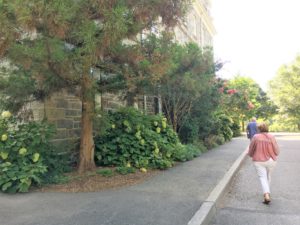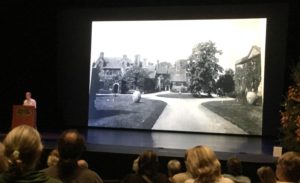Hello fellow readers, I’m back from the Woody Plant Conference held at Scott Arboretum at Swarthmore College PA, always a treat. While not nearly as knowledgeable as the scientists and arborists in attendance, I have a love affair with trees, especially those that have lived far longer than we have, such as the baobab tree of life.
I treasure trees longstanding stability, their quiet offering of oxygen and cleaning our air of carbon dioxide, plus their sheer beauty. Yes, I’m known to hug more than a few (no giggling until you’ve tried it.) There’s an energy about being rooted and reliant on our dear earth; we have that in common with trees.
Two to three-thousand-year-old Baobab trees are dying.
Starting off the conference was Claire Sawyers, Director of Scott Arboretum, who mentioned how our essential trees such as “ash, oak, and Picea (spruce) are all under threat of disease.” She references a recent article about the demise of two to three-thousand-year-old baobabs (Adansonia) in South Africa. “They’re known as the Tree of Life as they provide fruit even in long periods of drought.” Claire didn’t say why they were dying while expressing deep sadness.

Baobab tree / Tree of Life photo compliments of my clients Kathy & Bob England, who just returned from South Africa
A baobab tree, also known as boab or boaboa, can store thirty-two thousand gallons of water to sustain itself through severe droughts, which occur routinely in their homeland. They can grow to ninety-eight feet with trunks up to thirty-six feet wide – too huge to hug!
When leafless, their branches look like spindly roots, hence another common name of Upside-down Tree. Since the beginning of this century, the oldest Trees of Life in Africa are dying off too quickly to blame on pests, or disease experts say. I had thought perhaps they’d reached their life expectancy. Not so, as many live five to six thousand years! Scientists have yet to pinpoint the cause, though many surmise climate change which seems curious. Indeed, there’s no shortage of changes endured in two or three thousand years, including severe floods, volcanos, and extended drought.
Wakehurst–Kew’s Wild Botanic Garden in Sussex, England
Next was Ed Ikin of Wakehurst – Kew’s Wild Botanic Garden in Sussex, England. The garden is filled with temperate plants from New Zealand, South Africa, Tasmania, Chile, Argentina, Australia, and North America’s temperate regions. All planted in a natural setting with “rarity and beauty providing the framework of where they live in the garden,” explained Ikin. His expeditions slide presentation was much like watching an on-land version of The Undersea World of Jacques Cousteau.
Wakehurst’s Millennium Seed Bank
Ed then spoke about Wakehurst’s Millennium Seed Bank and the goal of archiving twenty-five percent of the world’s plant species by 2025, focusing on plants that provide food, education, or endangered. “They’re saved in such a way to survive a nuclear explosion,” hardly pleasant to think about and accentuated by their partnership with “the Doomsday Seedbank in Norway,” more congenially called the Svalbard Global Seed Vault I later found out.
Plant Exploration with a Purpose
Speaking of adventurers, Scott McMahan of the Atlanta Botanical Garden talked about Plant Exploration with a Purpose. Admirably one mission is to help those isolated in areas not yet familiar with agricultural techniques needed for survival, some obvious to us such as drainage holes in propagation bags to prevent root rot. Scott shared slides of food offered by villagers like stinging ants wrapped in leaves, “but they’re high in protein.” He didn’t partake in aged rats pictured in a petrified state, though; his talk a preamble to the lunch break. A vegetarian lunchtime offering seemed to gain popularity :^). Garden Dilemmas? AskMaryStone@gmail.com (and now on your favorite Podcast App.)
Column updated 2/18/21
“Nature never did betray the heart that loved her,” William Wordsworth’s famous words are worthy of contemplating at Scotts Arboretum.
You’ll enjoy a related column Talking to Trees on Arbor Day
Baobab Tree of Life is also featured on Episode 25 of the Garden Dilemmas Podcast:
Helpful Links:
Wakehurst – Kew’s Wild Botanic Garden






Thanks as always for a great read! Just a quick note on the Svalbard Vault. I would feel much better about all those seeds being saved if it weren’t for the fact that Monsanto, Syngenta, The Gates and Rockefeller Foundations hadn’t invested so much money to establish it. Both Monsanto and Syngenta are in the business of destroying crop diversity instead of preserving it, according to Natural
News reporter, Daniel Barker. (http://www.naturalnews.com/2016-12-06-svalbard-arctic-seed-vault) Another interesting factoid is that 10 companies now own as much as 90% of all the seed cultivated throughout the world. And again, Monsanto, Syngenta and DuPont combined own more than 50% of those seed patents. Worldwide, there are more than 1,700 gene banks that hold collections of food crops for safekeeping, but many are vulnerable to natural catastrophe, war, lack of funding, or just poor management. Currently there are 860,000 seed samples in the vault at Svalbard….
Hello April, it is hard to feel good about seeds being saved that could be genetically modified… Thanks for sharing! Mary